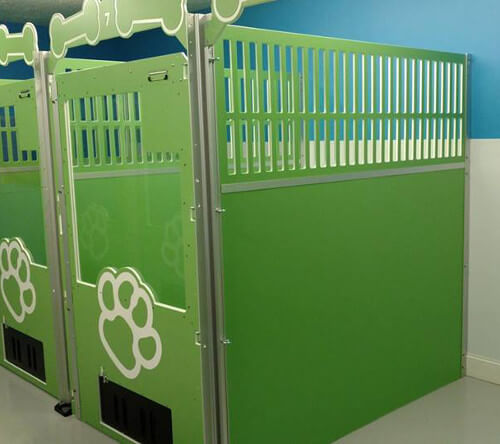Starting Your Own Dog Daycare or Boarding - Kennel Safety

This is part of a series of blog posts about starting your own dog daycare or boarding business.
Click here for the entire series
As a kennel manufacturer, our first priority is to ensure that the kennels are safe. This is a daunting task as there are many variables to consider.
Containment:
First is keeping the occupant fully contained. Kennels that a dog can easily escape defeats the purpose and a loose dog can get into all kinds of mischief! Some dogs can jump incredibly high. In fact, the world-record high-jump is roughly 5' tall. This was accomplished with a dog who had a running start, so kennels that do not offer enough room to get up to speed helps. Additionally, our kennels are 6' tall - just in case. That said, if there are beds, toys, or other items placed in the kennel, some dogs have figured out to use these extra items to get enough extra height to make it out. In these cases, it is best to not have other objects in these kennels - or put a lid on the kennel. (We do offer lids - but only recommend them for the known trouble-makers as it does add a lot to the overall kennel price). Some dogs climb out of kennels - we keep that from happening by making the side panels smooth. If there are no places a dog can set its paws to climb - it has a much harder time to climb out.
Sometimes problem occur if a dog can get just a part of its body out of the kennel. For example, if its head or paw can fit through the bars. The dog might choke if its head just barely fits. Or the dog might twist funny - cutting off circulation or pinching itself. Our slots are much narrower than other kennel manufacturers to avoid this problem. Additionally, we keep a much larger webbing between the slots. This keeps the dogs from being able to bend or break the mesh.
Kennel Failure:
This brings us to the next set of variables to consider. How will the kennels fare as they age? Many kennels are made from welded wire, welded mesh, or tubing. The problems with welds is that only one needs to be weak on the gate or panel to cause a problem. The dogs WILL find any weak welds and work at them until they finally break. This can cause immediate harm to the dog as the broken weld is typically sharp. It can also cause harm later on as the broken area might be large enough for a dog to get a paw or head through the broken part. We chose to construct our kennels with a 'one-piece' construction. This means we start out with a solid piece of material and cut out the slots for viewing. This type of construction means we do not have weak-points - and we've eliminated welds altogether!
Dogs being... dogs:

Dogs are highly intelligent - and this can sometimes get them into trouble. They like to 'feel' with their nose - or taste things with their tongue. These two senses provides the dogs a lot of information about who was using the kennel before they were in it. The problem is, these two parts are very sensitive and cut easily. A sharp weld-spot, a broken wire, or a rough area can cut or injure a dog. Sometimes the dogs are smart enough to realize the sharp-point or weld caused the pain and avoid touching it again. However, there are times when the dog attacks the 'phantom' causing the pain - inflicting more pain and injury on itself. This can be frustrating for the caregiver as it is not always apparent where or what the dog is injuring itself on. Again, having kennels that do not have sharp-points, welds that can break, and areas a dog might catch a toenail is the best prevention of these types of injuries.
Hidden Dangers:
One big hidden danger of kennels is the inability to clean every nook and crevasse. Dog hair tends to gather in these places and molds and bacteria love to grow on the hair. Add a little urine and water every once in a while and you have a perfect spot for diseases to grow. Some of these areas can be very small - which reduces the likelihood of spreading disease... but the fact remains that it is still there. Dogs have a knack for sniffing out these hairs or licking-up the remnants of the previous occupant. They do this to see who was in there before - but it is not sanitary. This is why we need to build kennels that are as easy to clean as possible. We also build kennels that have as few 'connect-points' as possible. By having smooth side panels and gates that are solid one-piece construction means we reduce the areas that hair might gather.
As you can see, there are a number of ways we can engineer and build the kennels to be a safe place for the dogs. Next time, I'll discuss how we make the kennels more useful to the caregiver. After all, anyone can make a box to put a dog in - but a useful kennel has features to make it better. Feel free to give us feedback on our Facebook Page!
